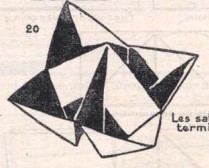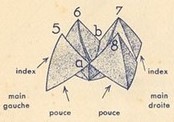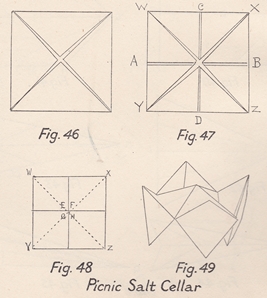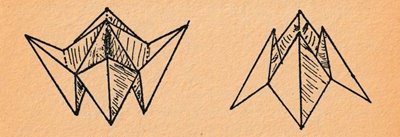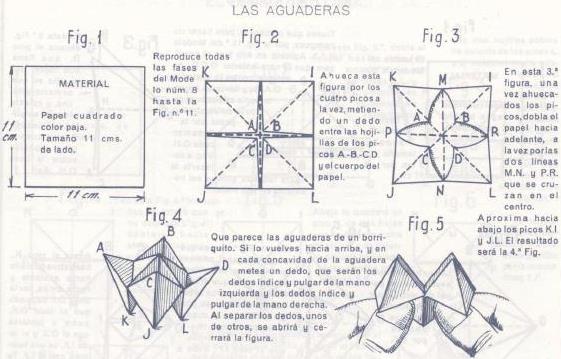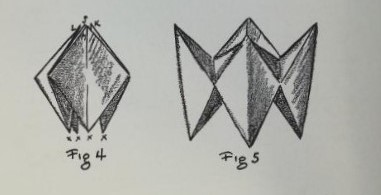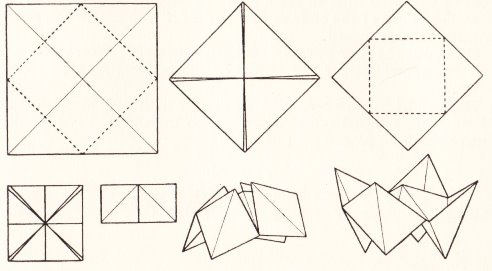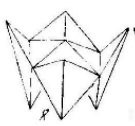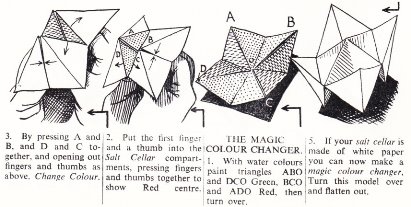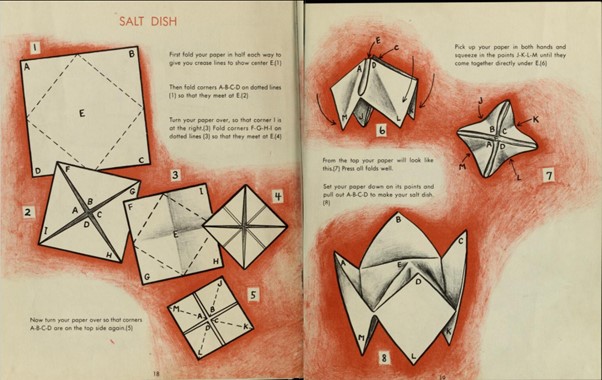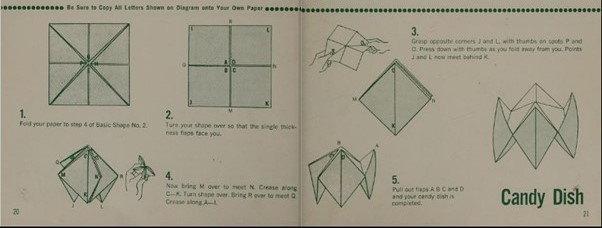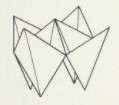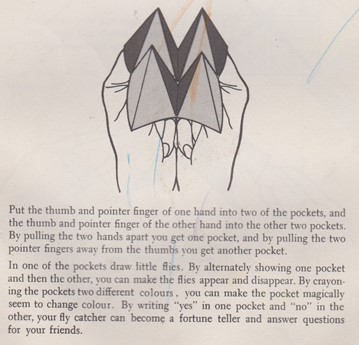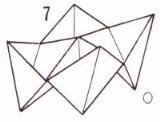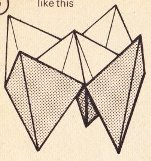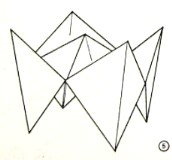| The Public Paperfolding History Project
Last updated 17/12/2025 x |
|||||||
| The Salt Cellar / The Pepperpot | |||||||
This page is being used to collect information about the history of the traditional designs known as the Salt Cellar , and the Pepperpot, which is made by folding the outside corners of the Salt Cellar inwards. Please contact me if you know any of this information is incorrect or if you have any other important information that should be added. Thank you. The Salt Cellar has many other names, which reflect the various uses to which it can be put as an entertainment eg Himmel und Holle, The Fortune Teller, The Cootie Catcher (particularly in the USA) and Chatterbox. Information about the various derivatives of the Salt Cellar and Pepperpot designs can be found on the page devoted to the History of Froebelian Folds of Life developed from the Double Blintz basic form and the Windmill Base. As the state of the evidence stands at present, it is by no means impossible that these designs were the invention of Friedrich Froebel, who certainly originated the use of the Double Blintz Base, from which both designs are made, as a starting point for the development of Folds of Beauty. The only known reference to a paper salt cellar prior to Froebel's death in 1852 is from 1836 (see entry below), but the salt cellars in this passage could well be some other type of design, such as a simple box. ********** In China (and in publications by Chinese authors) 1934 The Salt Cellar appears as 'Five Flavour Bottle' in 'Zhezhi Xinfa' (New Ways to Fold Paper), which was published by The Commercial Press in China in 1934, where it is decorated to be used as a simple colourchanger. . ********** In Japan (and in publications by Japanese authors) In his article 'History of Origami in the East and the West before Interfusion', published in 'Origami 5: Fifth International Meeting of Origami, Science, Mathematics and Education' in 2011, Koshiro Hatori asserts that, ''Many of the European origami models contained in Krause-Boelte's book (ie 'The Kindergarten Guide') are not included in contemporary Japanese records. The pig, house, sofa (also known as piano or organ), balloon (waterbomb), arrow (paper plane), salt cellar (cootie catcher), bird (pajarita or cocotte) and windmill ... were all born in Europe and imported into Japan along with the kindergarten system.' I do not know when this design was first published in Japan (but see entry for 1959 below). ********** In Europe and the Americas 1836 The earliest reference to a paper salt cellar that I know of occurs in the November 1836 issue of The Lady's Book (otherwise known as Godey's Lady Book), a women's magazine published in Philadelphia, USA, in a story entitled 'The Officers'.
Unfortunately, since there is no illustration, it is impossible to know how the paper salt-cellars referred to here were made. ********** 1859 A list of paperfolds suitable for use in kindergartens, on the Froebelian model, which can be found in the book 'Manual Pratique des Jardins d'Enfants de Freidrich Froebel' edited by J-F Jacobs, which was published in Brussels and Paris in 1859, includes designs called 'La Saliere' (the Salt Cellar) and 'La Poivrière' (the Pepperpot). There are no illustrations in this book but comparison with later works, which are illustrated, and which show the listed designs in a very similar order makes it almost certain that these designs can be identified in this way. ********** 1861 There is mention of a design titled 'Salzgestell' (salt dish) in a list of 'Lebensformen' (Forms of Life) in 'Das Paradies der Kindheit' (The Paradise of Childhood) by Lina Morgenstern, which was published in Leipzig in 1861. Unfortunately there is no illustration of the design. ********** 1863 The Pepperpot (Het peper-en zoutvat) is illustrated in 'De Kleine Papierwerkers' by Elise Van Calcar which was published by K H Schadd in Amsterdam in 1863. As far as I can tell the Salt Cellar is not mentioned in this book.
********** 1869 A design called 'Ein Salznapfchen', which is not illustrated, but which from the context is most probably the Salt Cellar, appears in a list of designs in 'Der Kindergarten' by Hermann Goldammer, which was published by Habel in Berlin in 1869. ********** 'Paradise of Childhood' by Edward Wiebe, which was published by Milton, Bradley and Company in Springfield, Massachusetts in 1869, and is effectively a translation of Goldammer's 'Der Kindergarten', similarly includes a 'salt-cellar' in its list of Forms of Life. ********** 1873 There is reference to 'La saliere' in a list of designs in 'Exercices et Travaux pour les Enfants Selon la Méthode et les Procédés de Pestalozzi et de Froebel' by Fanny and Charles Delon, which was published by Librairie Hachette in Paris in 1873. Unfortunately there is no illustration to confirm the identification of the design. ********** There is mention, but no illustration, of a 'Salz und Pfeffersabchen' in 'Die Praxis Des Kindergartens' by August Koehler, which was published by Herman Bohlau in Weimar in 1873. The same section of the book also refers to, but does not illustrate, a 'Lowenmaul' (Snapdragon), which is most probably a reference to a Salt Cellar used as a snapper. ********** There are folding instructions for the Saltcellar, but no illustration, in 'Bilder aus dem Kindergarten fur Mutter und Erzhieherrinen' by Ernst Barth, which was published in Leipzig in 1873. ********** 1875 The Pepperpot appears as 'Peper en zoutvat' (salt and pepper shaker) in 'Froebels Methode' by Elise Van Calcar, which was published in 1875.
********** 1876 Diagrams for the Salt Cellar are included in 'Des Kindes Erste Beschaftigungsbuch' by E Barth and W Niederley, which was first published in Bielefeld and Leipzig, and the foreword of which is dated October 1876.
********** The Salt Cellar is mentioned as 'un salero' in 'Manual Teorico-Practico de Educacion Parvulos' by D Pedro de Alcantara Garcia, which was published in Madrid by the Imprenta del Colegio Nacional de Sordo-mudos y de Ciegos in 1879. The author describes how to make various simple geometric folds culminating in The Double Blintz Basic Form and then says: 'Put a finger in each of the small squares and press them together ... We have un salero here. From this figure ... we will move on to others ... Only when students have exercised for some time in this kind of work and it is known that they are somewhat skilled ... are they allowed to invent forms (for themselves)'.
********** 1880 In 'Maakt de Kinderen Gelukkig' by Elise Van Calcar, which was published by H C Van Calcar in Gravenhage in 1880, there is a probable reference to these designs as 'het peper en houtvat', although no illustrations are provided. ********** 'The Kindergarten Principle' by Mary J Lyschinska, which was published in London in 1880 by Wm Isbister Ltd, contains mention of four designs, the Work Basket with Four Pockets (presumably the Salt Cellar), the Travelling Bag (presumably the Travel Bag), the Flower and Another Flower. Unfortunately no illustrations of these designs are provided. ********** 1882 Both the Salt Cellar and the Pepperpot, which is titled the 'Cake Dish', appear in 'The Kindergarten Guide' by Maria Kraus Boelte and John Kraus, which was probably first published by E. Steiger and Company in New York in 1882.
********** 1887 The Pepperpot appears as 'Salz und Pfeffertaschen' (Salt and Pepperbags) in part 2 'Die Praxis' of 'Theoretisches und praktisches Handbuch der Fröbelschen Erziehungslehre' by Bertha von Marentholtz-Bülow, which was published by George H Wigand in Kassel in 1887.
********** As 'Saliere' in 'Le Travail Manuel a L'ecole Primaire' by M. Coste et J. Lapassade, which was published by Lafon, Vve Ribaut et Tonnet in Pau and A Jeande in Paris in 1887.
********** 1890 As 'Porte-cigares' (cigar holder ie the Salt Cellar) and 'Saliere' (the pepperpot) in 'Le travail manuel a l'ecole et dans la famille' by MM, Bertrand, Toussaint and Gombert, which was published by Loucene, Oudin et ces Editeurs in Paris in 1890.
********** 1891 There is reference to salieres in the 'Bulletin de la Societe de Protection des Apprentis', an official document issued by the Societe de Protection des Apprentis et des Enfants Employes par les Manufactures in Paris in 1891. ********** The Salt-Cellar also appears in: 'Pleasant Work for Busy Fingers' by Maggie Browne, which was published by Cassell and Company in London in 1891. This book is an English version of 'Des Kindes Erste Beschaftigungsbuch' enhanced by the addition of a few extra designs. ********** 1892 'Le Travail Manuel a L'ecole Primaire' by Jully & Rocheron, which was published by Librairie Classique Eugene Belin in Paris in 1892, contains instructions for making the Salt cellar under the title 'Petit Vide-Poches' (Small Empty Pockets).
.********** 'The Prang Primary Course in Art Education: Part 1: The First Primary Year' by Mary Dana Hicks and Josephine C Locke, which was published by the Prang Educational Company in Boston in 1892.
********** 1893 Both designs appear in 'L'Annee Preparatoire de Travail Manuel' by M P Martin, which was published by Armand Collin & Cie in Paris in 1893, the Salt Cellar as 'Petite Saliers a Quatre Compartiments' and the Pepperpot as 'Vide-Poches a Quatre Compartiments'.
********** The Salt Cellar appears as 'Workbasket' in 'Paper and Scissors in the Schoolroom' by Emily Weaver, which was published by Milton Bradley Company in Springfield, Massachusetts in 1893.
********** 1895 Both designs appear in 'Course of Paperfolding' by Eleonore Heerwart, which was published by Charles and Dible in London and Glasgow in 1895, the Salt Cellar as 'The Salt-Cellar' and the Pepperpot as 'A Workbasket'.
Note that in the Introduction to this work the author mentions the Salt-Cellar as being one of the designs that existed before Froebel's time.
********** 1897 Both design appear in Lois Bates' 'Kindergarten Guide', which was first published by Longmans, Green and Co in London in 1897 The Salt Cellar is called 'The Cruet' and the Pepperpot is called 'The Salt-cellar' in this book.
********** 1899 The Salt Cellar appears as 'La Saliere' in 'Le Livre des Amusettes' by Toto, which was published in Paris by Charles Mendel in 1899.
********** 1900 Four tiny Saltcellars are pictured on a Table in 'Introduccion a la Ensenaza Practica del Sistema de Kindergarten' by Ernesto Steiger, which was published by E Steiger and Co in New York in 1900.
********** 1902 As 'Purera y salero' in 'Guia Practica del Trabajo Manual Educativo' by Ezequiel Solana, which was published by Editorial Magisterio Español in Madrid in 1902.
********** 1904 As 'Salzfass (Himmel and Holle)' in 'Handbüchlein der Papierfaltekunst' (Handbook of Paperfolding Art) by J Sperl, which was first published by by H Hartleben's Verlag in Wien and Leipzig in 1904.
********** 1907 The Salt Cellar design appears as 'Hornilla' (stove) in an article titled 'El trabajo manual escolar' by Vicente Casto Legua in the January 1907 issue of the Spanish magazine 'La Escuela Moderna' which was published in Madrid by Los Sucesores de Hernando. The Hornilla is not illustrated or mentioned in the text of this article but the notes on this design in Part 4 (the February issue) make it clear that this design is the Salt Cellar.
This says, roughly, 'This is what children call a construction that precedes the pajarita because it bears some resemblance to old stoves. It is also used for a guessing game called Night and Day which is played by inserting the fingers in the folds of the paper making them open and close quickly while another child guesses if it will remain open, saying 'day', or if it will remain closed, saying 'night'.' ********** 1910 Both the Salt Cellar and the Pepperpot appear in Part 2 'Das Flechten' of 'Die Frobelschen Beschaftigungen' by Marie Muller-Wunderlich, which was published by Friedrich Brandstetter in Leipzig in 1910.
********** As 'Work-Basket' in 'Educational Handwork' by T B Kidner, which was published by The Educational Book Company Limited in Toronto in 1910.
********** As 'Paper Salt Cellar' in 'Handicraft in the School', which was issued in four volumes by Gresham Publishing in London in 1910.
********** 1923 As a serviette fold, called 'Panniers', in 'More Paper Magic' by Will Blythe, which was first published by C Arthur Pearson in London in 1923.
********** 1923 As 'El Salero' in 'Trabajos Manuales y Juegos Infantiles' by Francisco Blanch, which was published by I. G. Seix y Barral Hermanos S.A.- Editores in Barcelona in 1923.
********** 1928 As 'pig's foot, or, as some prefer to call it, a nose pincher' in 'Fun with Paperfolding' by Murray and Rigney, which was published by the Fleming H Revell Company, New York in 1928.
********** As a colour-changer in an article titled 'Tricks and Twists with Paper', written by Sam Brown, in the February 1928 issue of Popular Mechanics magazine.
********** c1929 As 'Salero' in booklet 2 of 'Trabajos Manuales Salvatella - Plegado de figuras de papel', which was published by Editorial Miguel A Salvatera in Barcelona, pobably in or around 1929.
********** 1930 As 'Les Salieres' in the issue of the French children's magazine 'L'Age Heureux' of 21st August 1930.
********** 1931 As 'Himmel und Holle / Salzfalz' in the revised 3rd Edition of 'Lustiges Papierfaltbüchlein' by Johanna Huber, which was published by Otto Maier in Ravensburg, Germany in 1931. The text says, roughly, '... which you can open on each side with two fingers. One opening is then made black with a pencil or ink, that is 'hell', the other is 'heaven'. If you turn the figure over you have the Saltcellar.'
Inter alia, the Foreword states, roughly, 'The folding of paper ... is an old, evergreen custom of families which has been passed down more or less from generation to generation ... boys and girls fold 'heaven and hell' out of torn-off leaves of paper, often at school, to the delight of teachers.' ********** 1932 As 'A Paper Cruet' in 'Winter Nights Entertainments' by R M Abraham, which was first published by Constable and Constable in London in 1932.
********** As 'Les Salieres', in Booklet 2 of 'Images a Plier', a series of 6 booklets published by Librairie Larousse in Paris in 1932.
********** As 'Salero', in Booklet 1 of 'Figuras de Papel', a series of 3 booklets published by B Bauza in Barcelona in 1932. No image available. ********** 1933 As 'Ciel-Enfer' (Heaven-Hell) in 'Jeux de pliages' by Ferdinand Krch, which was published by Flammarion in Paris in 1933.
********** 1936 In 'Allerlei Papierarbeiten' by Hilde Wulff and Carola Babick, which was published in Leipzig and Berlin in 1936. The design is mentioned in the text as 'Himmel and Holle' (Heaven and Hell) but not illustrated ********** 1937 As 'Picnic Salt Cellar', in 'Paper Toy Making' by Margaret Campbell, which was first published by Sir Isaac Pitman and Sons Ltd in London, probably in 1937, although both the Foreword and Preface are dated 1936, which argues that the book was complete at that date.
********** 1939 As 'Birrete o salero' (Cap or Salt Cellar) in 'Trabajo Manual Educativo' by Araminta V Aramburu, which was published by F Crespillo in Buenos Aires in 1939.
********** As 'Las aguaderas' and 'Cielo y infierno' 'El Mundo de Papel' by Dr Nemesio Montero, which was published by G Miranda in Edicions Infancia in Valladolid in 1939.
********** As 'The Crown' in 'Fun with Paper' by Joseph Leeming, which was published by Spencer Press Inc in Chicago in 1939.
********** 1940 As 'A Cruet, or Sweetholder' in 'At Home Tonight' by Herbert McKay, which was published by Oxford University Press in London, New York and Toronto in 1940.
********** As 'Salero' in 'El Plegado y Cartonaje en la Escuela Primaria' by Antonio M Luchia and Corina Luciani de Luchia, which was published by Editorial Kapelusz in Buenos Aires in 1940,
********** 1952 As 'Salero' in 'Una Hoja de Papel' by Lorenzo Herrero, which was published by Miguel A Salvatella in Barcelona in 1952.
********** 1955 In the USA the salt cellar is also known as the Cootie Catcher (although this name is also given to a version of the hexaflexagon, something which can, and does, cause confusion when the two designs are conflated). In his article 'Martin Gardner and Paperfolding', available in the Lister List, David Lister states that Martin Gardner contributed a regular monthly column to Hugard's Magic Monthly between March 1951 and March 1958. These columns were later brought together in book form as the “Encyclopedia of Impromptu Magic”, published by Magic Inc. of Chicago in 1978. David says that 'the section on Paper Folding, as such, is eight pages long' and that 'The models mentioned or reproduced include ... the Salt Cellar in its various forms of "bug catcher" and "fortune-teller"'. I have not been able to access the text of Hugard's magic monthly but indices available on-line show that there were articles by Martin Gardner on Paper Folding in the issues for Dec 1955 and Jan 1956. This appears to be the earliest known instance of mention of the salt cellar in its cootie catcher guise. ********** 1956 'Paper Magic' by Robert Harbin, published by Oldbourne in London in 1956, contains diagrams for two versions of the design, the classic version under the name Salt Cellar and a second version called the Magic Colour Changer which is manipulated in the same way as the Fortune Teller.
********** 1959 In their 1959 book 'Lore and Language of Schoolchildren' folklorists Iona & Peter Opie mention the use of a salt cellar as a "Film Star Oracle". 'A sheet of clean paper about seven inches square (usually torn from an exercise book), is folded diagonally both ways to mark the centre and flattened out again. Each corner is folded into the centre and the whole paper is then turned over and laid on its face, and the four new corners are folded into the centre to make a 3 l/2-inch square. The paper is next turned face uppermost again and the names of four or more film stars are inscribed across each of the four squares which have been made, while the name of a flower is written in each of the eight triangles which have been formed on the back of the oracle. It is then opened by lifting up each of the four flaps and eight predictions . . . are written in each of the triangles corresponding to the names written on the other side. The corners are then folded back again to the centre. Next the paper is folded in half and in half again, to make a 1 3/4 inch square. This is then slightly opened out with the points held uppermost and the first finger and thumb of each hand are inserted into pockets, under the flaps which bear the film stars' names ...' ********** The design also appears: 1959 As 'Salt Dish' in 'Fun-time Paper Folding' by Elinor Tripato Massoglio, which was published by Childrens Press in Chicago in 1959. The designs in this book are said to have been learned in Japan.
********** 1960 As 'Candy Dish' in 'Origami: The Oriental Art of Paper Folding' by Harry C Helfman, which was published by Platt and Munk Co Inc in New York in 1960.
********** 1961 In 'The Art of Origami' by Samuel Randlett, which was published by E P Dutton in New York in 1961.
********** As 'Pfeffer-und Salznapfchen' in 'Wir Falten' by Joachim Schönherr and Gerta Schumann, which was published by Rudolf Arnold Verlag in Leipzig in 1961. ********** 1962 In 'Folding Paper Puppets' by Shari Lewis and Lillian Oppenheimer, which was published in 1962. Here the Salt Cellar design wis made into a talking Cat puppet, attributed to Ligia Montoya, by the addition of drawn-on eyes. ********** 1963 As 'Fly Catcher' in 'Folding Paper Toys' by Shari Lewis and Lillian Oppenheimer, which was first published by Stein and Day, Inc in the USA in 1963.
********** 1964 In 'Secrets of Origami', by Robert Harbin, was published by Oldbourne Book Company in London in 1964 as part of the Multiform sequence.
********** 1968 As 'Salt Cellar and Colour Changer', in 'Teach Yourself Origami: The Art of Paperfolding' by Robert Harbin, which was published by The English Universities Press in 1968.
********** 1968 In 'Your Book of Paperfolding' by Vanessa and Eric de Maré, which was published by Faber and Faber in London in 1968, where it is said to be a traditional Japanese design.
********** 1970 A colour-change version appeared as 'Coloured Salt Cellar / Colour Changer' in 'Origami Compendium No 1' by Robert harbin, which was published c1970.
********** |
|||||||




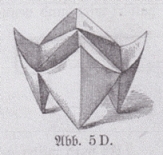

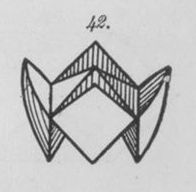
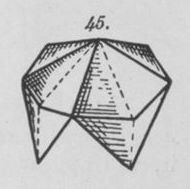



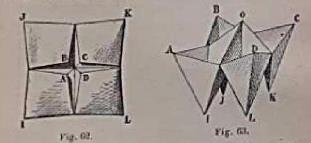
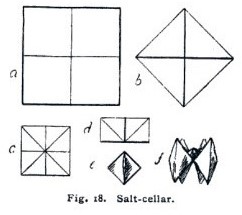

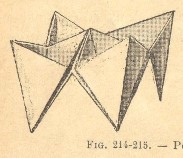
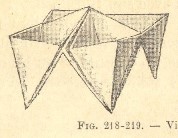
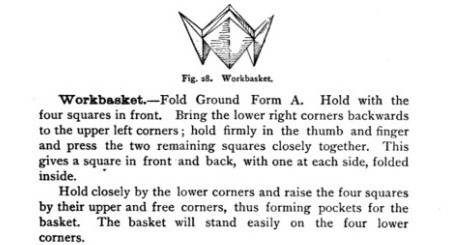
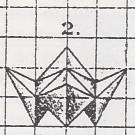
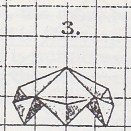



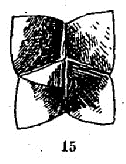
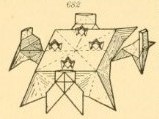




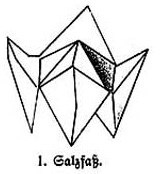
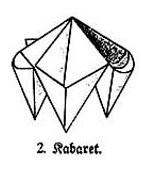

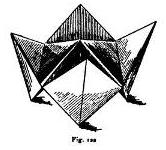
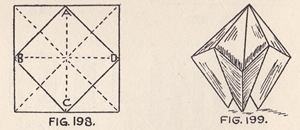
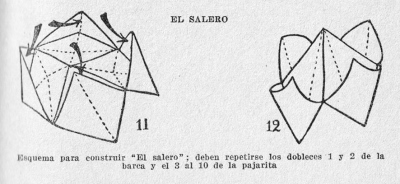
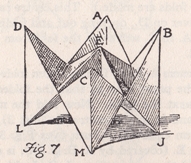
.gif)

